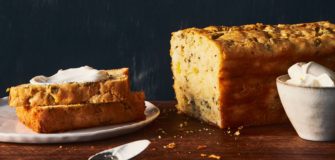Share
“Easier than tapping a maple tree. Like, much easier.”– Butter and Flower: Cannabis-Infused Recipes and Stories for the Cannacurious by Ann Allchin, TouchWood Editions
Maple Walnut Cookies
Servings 28 cookies
Ingredients
- ½ cup (113 g) cannabutter
- 1 cup (200 g) brown sugar
- 1 egg
- ½ cup (125 mL) real maple syrup 1 tsp maple extract
- 1¾ cups (249 g) all-purpose flour 1 tsp baking powder
- ½ tsp baking soda
- Dash of salt
- 1¾ cups (222 g) walnuts (¾ cups chopped; 1 cup walnut halves, tossed in olive oil and salt)
Instructions
- Preheat oven to 375°F and line baking sheet(s) with parchment paper or silicone mat(s).
- Melt the cannabutter in a double boiler or in a heat-proof bowl over a pot of simmering water.
- With your favourite mixer, combine the cannabutter and brown sugar. Add in the egg. Next go for the maple syrup and extract.
- In a separate bowl, stir together the flour, baking powder, baking soda, and salt. Add the dry ingredients to the mixing bowl. Add the ¾ cup chopped walnuts.
- With a 1-Tbsp cookie scoop, drop dough onto the baking sheet(s). These cookies will spread, so make sure they’re at least 1½ inches apart. Bake for 6–8 minutes.
- While the cookies are baking, toast the remaining walnuts in the microwave. In a microwave-safe bowl, nuke the pretty walnut halves in 2-minute increments until they start to smell lovely (no more than 6 minutes).
- The cookies are done when there isn’t a mound of dough in the middle, but they’re not completely cooked either. Bang the cookies two or three times on the counter to flatten them. If they don’t flatten, give them another 2 minutes in the oven. Decorate the cookie centres with 3 pretty toasted walnut halves on each cookie while they’re still warm.
Notes
Makes about 28 cookies with ½ cup cannabutter (about 5 mg THC per piece).
Note: Recipe can also be made with regular butter
Recipe by Ann Allchin from Butter and Flower, copyright © 2022 by Ann Allchin. Reprinted with permission of TouchWood Editions. touchwoodeditions.com
Cannabutter Recipe
Ingredients
- 7 g (1/4 oz) cannabis bud at approximately 16 percent THC content. (Don’t stress too much about finding this percentage. Bodily effects don’t shift greatly with minimal variation here.)
- 2 cups (454 g) unsalted butter
- 1 Tbsp sunflower lecithin optional—helps with overall consistency
Instructions
- Decarboxylate your cannabis by baking it in an oven-safe dish at 240°F for 1 hour. (This “activates” the THC and CBD by converting them from their acid forms.)
- Add about 2 inches of water to a medium saucepan, bring to a moderate boil, and set a heat.proof bowl on top, or use a double boiler, which is less likely to tip. Add 2 cups of butter and the lecithin (optional) to the bowl and allow it to melt. (I’m just going to call it butter from here on in— substitute in your mind for coconut or olive oils as needed.) Add 1 cup of water (with butter only) and your bud. (Or add water, butter, and bud to slow cooker. Skip adding water if infusing olive oil, as you won’t be able to separate it later. But be sure to keep temperatures low.)
- Allow the butter to heat without boiling for 3 hours (if you have a candy thermometer, aim for 160–200°F), stirring occasionally and making sure the saucepan doesn’t boil dry. (Or cook using a low-heat setting for 8–12 hours in a slow cooker.) This process extracts the THC from the green and binds it to the butter.
- Congrats, you now have cannabutter! Allow the magic you’ve created to cool until you can comfortably work with it, but make sure it stays liquid.
- Pour the cannabutter through a cheesecloth or fine sieve into a container. (Take care not to use plastic if the butter is still too warm.) Press as much butter out of the cheesecloth as you can, and discard the now-useless plant matter.
- Chill the cannabutter in the fridge. When solid, lift the infused butter from the container and turf the water that has separated to the bottom. Label and store the cannabutter in the fridge or freezer for later use—I usually go for freezing it because it’s heartbreaking to toss a precious infusion over concerns it’s gone bad. Don’t reheat cannabutter in the microwave.
Notes
BAG OF TRICKS
Kitchen scale
Double boiler (or medium saucepan with heat-proof bowl), or slow cooker
Candy thermometer (optional)
Cheesecloth or fine sieve
Sunflower lecithin (optional—can be purchased in health food stores or online) TIMING
1 hour for decarboxylation
3 hours for simmering (or 8–12 hours in a slow cooker)
10 minutes for sieving and fussing about
1 hour in the fridge to allow the butter/ coconut oil to resolidify for removal of water DOSE ASSUMPTIONS
Here we’re performing an extraction with 7 g (1/4 oz) of decarboxylated cannabis bud containing about 16 percent THC and 2 cups (454 g) unsalted butter, which should yield about 18 mg THC per Tbsp. SUGGESTED MOOD/STRAIN Maple Leaf Indica “is a heroic strain of Indica with fat leaves, plump buds, and caked with crystals,” according to Leafly. Sounds delicious! Recipe by Ann Allchin from Butter and Flower, copyright © 2022 by Ann Allchin. Reprinted with permission of TouchWood Editions. touchwoodeditions.com
Kitchen scale
Double boiler (or medium saucepan with heat-proof bowl), or slow cooker
Candy thermometer (optional)
Cheesecloth or fine sieve
Sunflower lecithin (optional—can be purchased in health food stores or online) TIMING
1 hour for decarboxylation
3 hours for simmering (or 8–12 hours in a slow cooker)
10 minutes for sieving and fussing about
1 hour in the fridge to allow the butter/ coconut oil to resolidify for removal of water DOSE ASSUMPTIONS
Here we’re performing an extraction with 7 g (1/4 oz) of decarboxylated cannabis bud containing about 16 percent THC and 2 cups (454 g) unsalted butter, which should yield about 18 mg THC per Tbsp. SUGGESTED MOOD/STRAIN Maple Leaf Indica “is a heroic strain of Indica with fat leaves, plump buds, and caked with crystals,” according to Leafly. Sounds delicious! Recipe by Ann Allchin from Butter and Flower, copyright © 2022 by Ann Allchin. Reprinted with permission of TouchWood Editions. touchwoodeditions.com
Recipe by Ann Allchin from Butter and Flower, copyright © 2022 by Ann Allchin. Reprinted with permission of TouchWood Editions. touchwoodeditions.com
Previous Article
RONDELLES SAUMONÉES
Next Article
CAKE SALÉ au poireau




